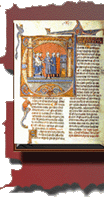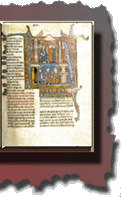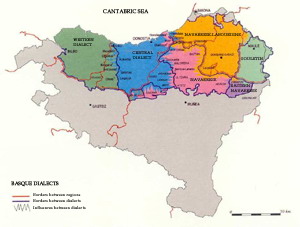
With the decline of the Roman Empire in the second half of the 3rd century A.D., the Basque tribes began a process of miscegenation and reinforcement, in which a greater intercommunication among the different Basque-speaker lands and a considerable political autonomy concerning the Imperial administration played important roles. That autonomy and cohesion of the Basque population increased even more with the arrival of the Germanic tribes since the year 400 (Visigoths and Franks), to whom the Basque people opposed strongly.
The arrival of the Visigoths in the Basque lands was performed through devastating pillage, what might certainly infuriate the population. As an answer to this situation, Basque incursions from the mountainous areas terrorized the invaders in turn, as recorded by Gregory of Tours in his work of the 6th century 'Historia Francorum', regarding the Basque attack to the Aquitanian plains in 587: 'The Vascones entered through the mountains and went down to the plains devastating vines and fields, burning the houses and taking with them many captives with their cattle. Duke Austrowald often acted against them, but causing little damage'.
Therefore, there were Vascon attacks from the mountains, which were very difficult for the Franks to punish. It must be remembered that the Vascon army came to siege Zaragoza in 653 under the reign of Chisdasuinth, and that all the Visigothic kings fought bravely against the Vascones with no exception. In this way, the weakening of the Roman power had allowed the empowerment of the Basque internal cohesion so that the arrival of the Visigoths took place before a community that already was quite compact and economically expansive.
The focus of the idiomatic and policy unification that arose during the late Roman period was led by the Vascones of Navarre with no doubt (since then, all the Basques were named Vascones). Consequently, the terms and grammatical modifications were spread throughout the Basque-speaker territories of those times that remained more isolated from the Celtic, Iberian or Latin influences. In that way, the development of Common Euskara for all the Basques was accomplished in the Frankish-Visigothic period (5th-6th centuries A.D.), what allowed in turn the beginning of the perception of being Basque as we know it today.
The dialects spoken by the Basques after finishing the development of Common Euskara during the 6th century, which were very similar to each other in the Frankish-Visigothic period, began to differentiate gradually and evolved to the current Basque dialectal situation.
The dialects that keep more archaic forms of Common Euskara or from the former Proto-Basque are Biscayan (western dialect), Souletin and the extinct Roncalese, due to their geographical remoteness. The Roncalese dialect was the most different and archaic of them (it disappeared in the 20th century) that was a possible remain of the ancient Basque language spoken in the Aragonese Pyrenees. Secondly, the Biscayan dialect should be mentioned since it had a lower phonetic evolution and kept auxiliary verbs as well as verbal endings that the rest of the dialects have lost over time (except Souletin and Roncalese). However, the Basque dialect that has evolved phonetically the most is Souletin due to the influence exerted by Gascon and Aragonese.
In order to understand those differences among the dialects, let us have a look at the following example: the term 'wine' was said in Common Euskara 'ardano'. The form used in Biscayan is 'ardao' (arda[n]o), while in the dialect of Guipúzcoa and in Standard Euskara is 'ardo' (ard[an]o). On the other hand, the term used in the northern Basque Country is 'arno' (ar[da]no) so that the Biscayan form is the closest one to the term that was used in Common Euskara. The fact that the term 'wine' was said 'ardano' in Common Euskara is supported by the word 'ardandegi' (wine shop), which consists of the fusion of the words 'ardano' (wine) and 'tegi' (house) that is used in turn by all the dialects. Therefore, the resulting meaning for 'ardandegi' would be 'the house of wine', where the term has become fossilized.
The comparative study of the differences among the Basque dialects does not allow us to indicate that there were differentiated languages of Basque stock before the rising of Common Euskara, as is the case with the Latin languages (Portuguese, Spanish, Catalonian, Italian...), but that each tribe spoke a dialect of the same language, Euskara. The increased differentiation among the Basque dialects arose over the last centuries as a result of the influences received from the surrounding Romance languages, what impacted their respective evolutions.
The reason that the westernmost Basque dialects keep today the geographical extension of the old Pre-Roman tribal demarcation is considered by Basque linguistics as a result of chance and therefore, it is not due to a tribal origin.
The areas in which colloquial Euskara has been kept.
Current division of Euskara dialects.
The territories in grey correspond to the areas in which the Basque language has disappeared and Spanish (to south) and Gascon or French (to north) are spoken today.
|
|
|
The current Basque dialects or 'euskalkis' (as said in Euskara) are the following ones:
The Biscayan dialect: it is known in Euskara as 'Bizkaiera' (Biscayan) or 'Mendebaldekoa' (western dialect) and it is the one that has the greatest number of speakers. Biscayan is spoken in the territory of Biscay from the Nervión river (to west) to part of the bordering western Guipúzcoa, as well as from the Cantabric coast to northern Álava (to south).
The dialect of Guipúzcoa: it is known as 'Gipuzkera', 'Ertaldekoa' or 'Erdialdekoa' (Central dialect), which is spoken in the territory of Guipúzcoa and in the far northwest of Navarre.
The Navarrese dialect: known as 'Nafarrera' (Navarrese), it is spoken in the north of Navarre and northeastern Guipúzcoa.
The eastern Navarrese dialect: it is known in Euskara as 'Ekialdeko Nafarrera' and it is spoken in northeast Navarre.
The Navarrese-Labourdin dialect: known in Euskara as 'Nafar-Lapurtera' that is spoken in Labourd, Lower Navarre and in part of Soule.
The Souletin dialect: it is known as 'Zuberera' and it is spoken in the territory of Soule and in the Bearnese canton of Oloron (Gascony)
With respect to the last two dialects, it should be mentioned that both are evolutions of Common Euskara during the Middle Ages that were caused by the influence of Gascon and in the case of Souletin, also by the Romance Aragonese language. On the other hand, the evolution of the southern dialects was impacted by Castilian and to a lesser extent, Aragonese.
Share this page!



